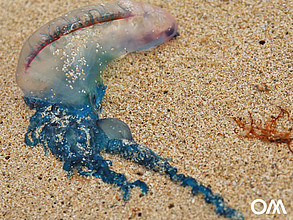Hello surfer!
Jellyfish are among the oldest living things on our planet. They are an important part of the food chain, looking strangely beautiful and alienly dangerous at the same time.
For us surfers in Fuerteventura, of course, not only the question arises: Are there jellyfish in Fuerteventura? ... because jellyfish are found in all seas and oceans. The more important question is: Are there dangerous jellyfish while surfing in Fuerteventura? ... and what do I have to look out for as a surfer in Fuerteventura when I see jellyfish or come in contact with them.
I start from before:
When will there be jellyfish in Fuerteventura?
As already mentioned, there are of course also in the waters around Fuerteventura jellyfish. On the coasts and beaches of Fuerteventura, jellyfish are very rare. We surfers are always near the beach and so today we should only be interested in when jellyfish could make us dangerous while surfing.
When jellyfish get washed up on the beaches of Fuerteventura, this is usually the result of certain environmental, weather and especially wind phenomena.
Several years ago, there was increased undersea volcanic activity in the waters of the Canary Islands. Canary experts know that there is almost an 8th Canary Island. It is still below the surface of the sea but due to volcanic activity it is steadily rising and will break through the water surface in a few thousand years.
At that time the water was warmer than usual due to this volcanic activity and this temporarily led to an increase of the jellyfish population - although still on the open sea.
However, before these jellyfish are washed ashore on the beaches, it requires certain wind directions, which also have to hold for a few days. Experience has shown that in recent years this has mainly been wind that came directly from the west. This directly west to southwest wind direction is very rare in Fuerteventura. If it occurs at all then usually in the spring around the month of May. But again, this does not have to be the case every year. The wind has to blow from this direction for a few days.
What do I have to do to avoid coming into contact with jellyfish while surfing?
Of course, this question already implies that contact with the jellyfish that can be washed ashore in Fuerteventura is rather unpleasant. Right. Physalia Physalis or Portuguese Galley is painful on contact but not life threatening.
To avoid the contact with jellyfish while surfing in Fuerteventura, it is already on the beach at the edge of the surf to see if there may be dead alluvial jellyfish.
If at first glance you find more than one jellyfish and several square meters are several, this is an alarm signal. However, it is rare, some years not at all and is the result of the weather and wind constellations described above.
If you still want to surf on such a day, you should wear a wetsuit. The suit is the best protection against jellyfish while surfing. In addition, one should pay attention in the water to the characteristic sail of the Portuguese galley. A kind of bubble that emerges from the water and serves as a sail for locomotion. You can also touch the sail with your bare hands without injuring yourself. The painful stinging cells sit underwater on the long tentacles.
What should I do if I come in contact with jellyfish while surfing?
1. Do not scratch the affected area (not even with sand), because otherwise even more nettle cells that are only on the skin could be activated.
2. Wash the area with salt water (tip: seawater). Never with fresh water! - and rinse off all remains of the jellyfish.
3. Do not treat with urine, vinegar or similar!
4. If necessary, remove the remains of the jellyfish tentacles with tweezers
5. Cool against the pain with ice. The ice should not have direct contact with the skin and should be applied for about 5 to 15 minutes.
6. Under no circumstances warm the affected area, for example by holding in the sun.
7. If the pain lasts longer, a doctor may prescribe creams or gels - in the worst case, a painkiller or antihistamine.
8. If the symptoms do not subside in a short time definitely consult a doctor.
9. It is good not to be alone in the next 48 hours, in the unlikely event of an anaphylactic shock.
Conclusion
It takes a very special and really rare wind direction for several days before on the beaches and in the waters in the immediate coastal jellyfish occur. When you come into contact with one of the Portuguese galleys, it is painful but no more dangerous than a wasp or bee sting. Allergy sufferers and children should be particularly careful, for all other surfers normal mindfulness applies. Surfers in Fuerteventura are again protected from jellyfish thanks to the wetsuit. Anyone suffering from respiratory distress, heat, fever, nausea and / or rash after contact with a jellyfish should definitely visit a doctor to avoid the risk of anaphylactic shock.

![[Translate to English:] Jellyfish in the water while surfing in Fuerteventura [Translate to English:] Jellyfish in the water while surfing in Fuerteventura](/fileadmin/_processed_/6/b/csm_Fuerteventura-qualle-wasser_f74caab4bd.jpg)